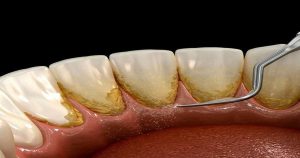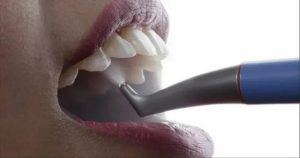1. Understanding Calculus Bridge
- Definition
- Explain how a calculus bridge develops when plaque hardens and accumulates on the gum line, usually creating a “bridge” connecting teeth with tartar.
- Difference Between Plaque and Calculus
- Define the distinction between plaque (soft, sticky layer) and calculus (hard mineralized deposits) and why calculus requires skillful removal.
- Visual Identification
- Explain how the calculus bridge is an oblique or brownish fleck on the teeth and the gum line. It is often evident.

2. Causes of Calculus Bridge Formation
- Poor Oral Hygiene
- Explain how the lack of flossing and brushing is a factor in plaque buildup. This is left untreated and forms calculus.
- Diet and Nutrition
- Discuss how a diet rich in carbohydrates and sugars feeds oral bacteria, which create plaque faster.
- Smoking and Tobacco Use
- Discuss the ways that smoking can increase the chance of calculus turning into plaque, typically due to decreased saliva flow and a boost in bacterial activity.
- Dry Mouth (Xerostomia)
- Discuss how the absence of saliva (which naturally cleanses your mouth) causes plaque buildup and the formation of hardening.
- Genetics and Medical Conditions
- Discuss how genetics, diabetes, and certain medications may improve the likelihood of developing plaque and calculus.
3. Symptoms of a Calculus Bridge
- Visible Tartar Deposits
- Discuss how hardened, yellowish, or brownish tartar may create an evident bridge near the gumline. Red and swollen gums accompanied by bleeding can be seen.
- Gum Bleeding and Sensitivity
- Explain how tartar can irritate gums, making them bleed easily, particularly when flossing or brushing.
- Chronic Bad Breath (Halitosis)
- Bacterial clogs in the calculus may cause bad breath, which is often in opposition to regular mouthwash or brushing.
- Gum Inflammation and Recession
- Examine how the buildup of calculus may cause inflammation and gingival recession by pushing the gums further away from the teeth.
- Potential for Tooth Decay
- Define how calculus may keep bacteria close to the enamel, making decay more likely to occur.
4. Risks of an Untreated Calculus Bridge
- Gingivitis and Periodontitis
- Particulars are the ways that untreated calculus bridges cause gingivitis (early-stage gum disease) and could develop into periodontitis, a severe condition that causes damage to the bone’s structure.
- Bone Loss and Tooth Mobility
- Discuss how periodontitis weakens teeth supporting bone, which could lead to loosening or even loss of teeth.
- Systemic Health Concerns
- It is important to note that bacteria that enter the bloodstream during gum disease can cause heart disease, diabetes-related complications, and respiratory infections for Calculus Bridge.
4. Treatment for Calculus Bridge
a. Professional Dental Cleaning
- Scaling and Root Planning
- Define the dental procedure of scaling. Dental professionals employ special tools to eliminate calculus of the teeth, mainly from gum line pockets.
- Root planning is the process of smoothing the tooth’s roots to allow the gums to reattach and stop the buildup of tartar.
- Ultrasonic Cleaners
- Ultrasonic instruments remove calculus deposits from the surface with water and vibration.
b. Antibiotic Therapy (if necessary)
- Local Antibiotics
- Discuss how dentists can use topical antibiotics on the gums for situations in which calculus has caused gum disease.
- Oral Antibiotics
- For severe cases of calculus bridge teeth, oral antibiotics can be prescribed to manage inflammation and infection caused by bacteria.
c. Optional Surgical Options (in advanced cases)
- Flap Surgery
- Explain flap surgery, where gums are lifted temporarily to reach and remove calculus deposits deep beneath the gum line.
- Bone and Tissue Grafts
- The grafting procedure is needed if gum disease caused by calculus on the teeth has led to significant bone loss around the teeth.

5. Prevention of Calculus Bridge
a. Daily Oral Hygiene
- Proper Brushing Techniques
- Brush day with an easy-bristled or soft-bristled toothbrush and toothbrush, focusing on keeping plaque to prevent up.
- Flossing
- Make sure you regularly floss to eliminate food debris and buildup between teeth, which is susceptible to calculus formation.
- Mouthwash Use
- Discuss how an antibacterial mouthwash could help reduce the number of bacteria that cause plaque buildup.
b. Regular Dental Checkups
- work-related Cleanings
- Make sure you get the practice of regular, skillful teeth cleaning at least every six months. This will allow dentists to remove plaque before it solidifies into calculus.
- Monitoring Dental Health
- Define how dental visits help dentists detect the first signs of plaque buildup or gum issues before they worsen.
c. Dietary Adjustments
- Limiting Sugars and Processed Foods
- It is suggested to reduce starchy and sugary foods that feed oral bacteria and can accelerate plaque development.
- Staying Hydrated
- Ensure you mention the importance of drinking plenty of water to improve saliva production, which helps wash away food particles and bacteria.
d. Lifestyle Modifications
- Quitting Smoking
- Stress that quitting smoking reduces the chance of developing calculus as well as gum disease and other dental health issues.
- Managing Health Conditions
- Suggestions for maintaining reasonable control of diseases like diabetes, which have been linked to increased risk of calculus buildup and gum disease.
Conclusion
-
- Review the most important aspects of the conditions, symptoms, causes, and prevention of calculus bridge.
- It is imperative to emphasize the importance of proactively caring for your teeth to reduce the risk of developing calculus and related health hazards.
- Instruct readers to visit their dentists frequently for perfect advice and treatment tailored explicitly to their oral health requirements.
FAQs
Is calculus bridge harmful?
Yes, a bridge made of calculus is harmful since it carries bacteria that can cause dental decay, gum disease, and bad breath. If not treated, it could lead to periodontitis, which can damage the teeth that support them and result in tooth loss. Regular cleanings of your teeth are vital to remove and prevent calculus accumulation.
How to get rid of calculus bridge?
To eliminate the calculus bridge causing you pain, you’ll require a competent dental cleaning. Hardened tartar cannot be eliminated with routine flossing or brushing. Dentists utilize special instruments for scaling to remove and break down the calculus. Maintaining good oral hygiene afterward helps prevent future buildup.
What are the side effects of calculus?
The negative consequences of calculus on teeth are gingivitis, bad breath, and a higher chance of developing gum disease, which can cause the gums to bleed and teeth to decay. If left untreated, the buildup of calculus could cause periodontitis and result in bone loss and possibly tooth loss. Also, it makes maintaining a clean mouth more difficult.
How do you know if you have calculus bridge?
Calculus bridge if you see hard brown, yellowish, or yellowish deposits along your gum line, which do not dissolve when you brush. Other indicators include bleeding gums, bad breath, and gum inflammation. A dental exam can determine the presence and severity of calculus accumulation.
Are There Products to Prevent Calculus?
I recommend electronic toothbrushes, water flossers, and anti-tartar toothpaste ADA-approved to ensure oral hygiene.
 aim specialty health Discover Expert Insights, Empower Your Wellness With Aim Specialty Health Blogs.
aim specialty health Discover Expert Insights, Empower Your Wellness With Aim Specialty Health Blogs.
